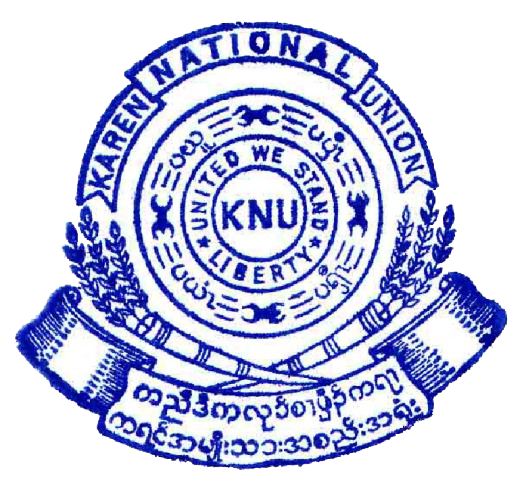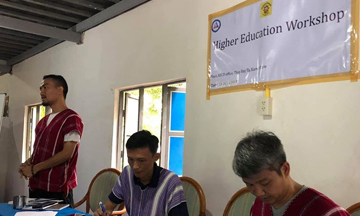
Department of Education & Culture

Karen National Union
Supreme Headquarters
Kawthoolei
Brief History of Karen Education
Colonial Period
In 1854, during the colonial period, there were no conflict and the Karen people had the chance to establish schools having free and peaceful access to education. There were 3 types of schools in Burma during colonial period.
Anglo Schools
The medium of the teaching was English apart from the subject Burmese. The students were mainly the children of westerners and elite families.
Anglo Vernacular Schools
The medium of teaching was English as primary language and Burmese as a secondary language. However, in 1926 the Karen Language could be taken as secondary language if the students wanted to. Karen Missionary High Schools were established in Pathein, Hinthada, Tharyarwaddy, Taungoo, Mawlamyine and Dawei. Karen Missionary Middle Schools were established in Nyaung Lay Bin, Pa Doh and Kyar Inn.
Methodist High Schools were also in Yangon and Taungoo. Anglican Middle Schools were in Taungoo, Nyaung Lay Bin, Rangoon, Mawlamyine, Myaung Mya and others cities. As per the above mentioned schools, the Karen people had more chances to attend school.
Vernacular Schools
Vernacular schools were mostly in the rural areas and few of them located in the cities. It was intended for students who were not well-off. Since 1912, Karen Schools were permitted to use the Karen Language as a teaching medium for all subjects until Grade 7. In 1936, Karen students could sit exams using Karen medium until Grade10. In 1924, Karen students were permitted to learn every subject in Pho Karen Language untill Grade-4.
During the colonial period, there were teacher training schools and also a missionary college, which was called Judson College. Many Karen people had the opportunitie to study abroad and achieved varieties of degrees and certificates during colonial period.
Karen Education after World War II
There were substantive changes to the education sectors in Burma after World War II.
1. The three types of Karen Schools were combined into one.
2. Curriculum was in Myanmar language and the Karen people lost the opportunity to learn in their Karen Language.
3. Karen Schools were cut off from the budget and support.
4. Karen Students who want to study abroad were interrupted in many ways, which later caused a weakness in Karen education.
The Karen Education Movement formed after the formation of the KNU government in 1956.
In 1956, every sectors were restructured including the Education Department.
- In 1958, a Teacher Training College was established in Doh Hei Dae Village, Mutraw District.
- Since 1958-1959, Kawthoolei College was established in Mutraw District.
1. Wai Mu
2. Plo Ta
3. Mae Wai
4. Kwee Ta Mae
5. Wah Lo Klo
- In 1987, EET 1 - year study program was opened.
- In 1988, EET 3 - year study program was opened.
- In 1989, EET 3 - year study program and 1-year study program opened.
- In 1991, Karen Teachers Training College (KTTC) opened in Pway Baw Lu.
KTTC school was moved to Bridge (6) area as the Headquarter of KNU moved in 1995. In 1996 the SPDC occupied the areas and the KTTC program was stopped.
- In 2004 KTTC school re-establish again in Yoe Kay.
- In 2002 Teacher Preparation College (TPC) program was started in Bae Kloh and Umpiem mainly donated by World Education till 2009.
- In 2005 TPC program started in Noe Po Camp.
- From 2005 to 2009, TPC program was run in Mae Ra Mo Camp.
- In 2006, L.M.T.C college started running in Mae La Camp.
- In 2008, IHE program started running in Mae La, Noe Po, Umpiem and Mae La Oo Camps.
Head of Department of Education (Central) from 1947.
1. Saw Hunter Thar Mwe 1947-1949
2. Padoh Saw Taw 1951- 1952
3. Padoh Saw Ba Htoo 1953- 1963
4. Padoh Saw Charly 1966-1969
5. Padoh Gay Dwel Bwa 1970-1974
6. Padoh Saw Baw Yu Paw 1974-1976
7. Padoh Ba Thein Sain 1976-1990
8. Padoh Shwe Ya Hal 1991-1999
9. Padoh Saw Lah Say 1999 -
Head of District Education Department (From 2000 – 2015)
1. Tha Hton District
2. Taungoo District
Remark: in 2011, there was no office and district department in Taungoo District.
3. Nyaung Lay Bin District
4. Myeik-Dawei District
5. Mutraw District
6. DooPlaya District
7. Hpa-an District
Currently, there is no Head of Hpa-an District Education Department.





